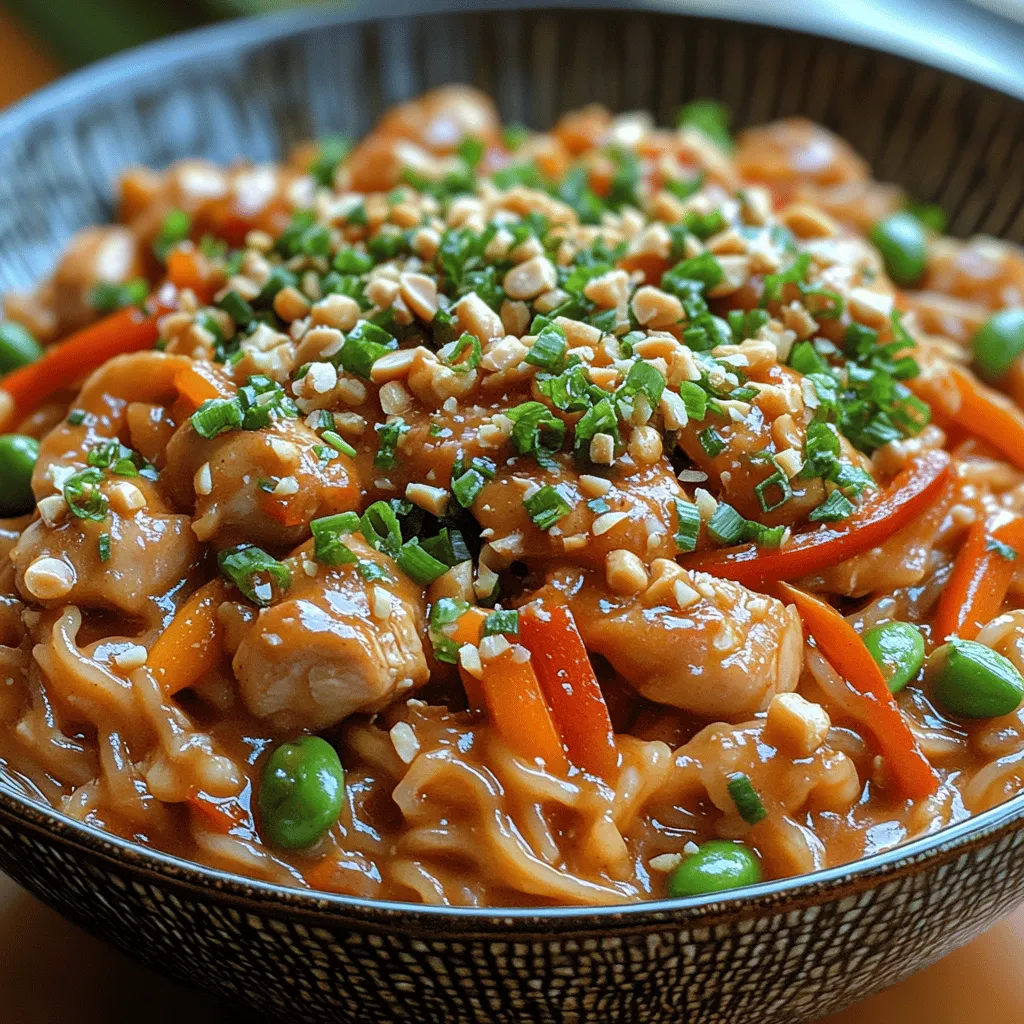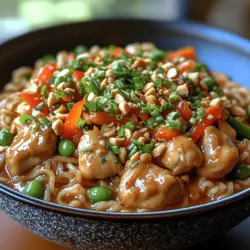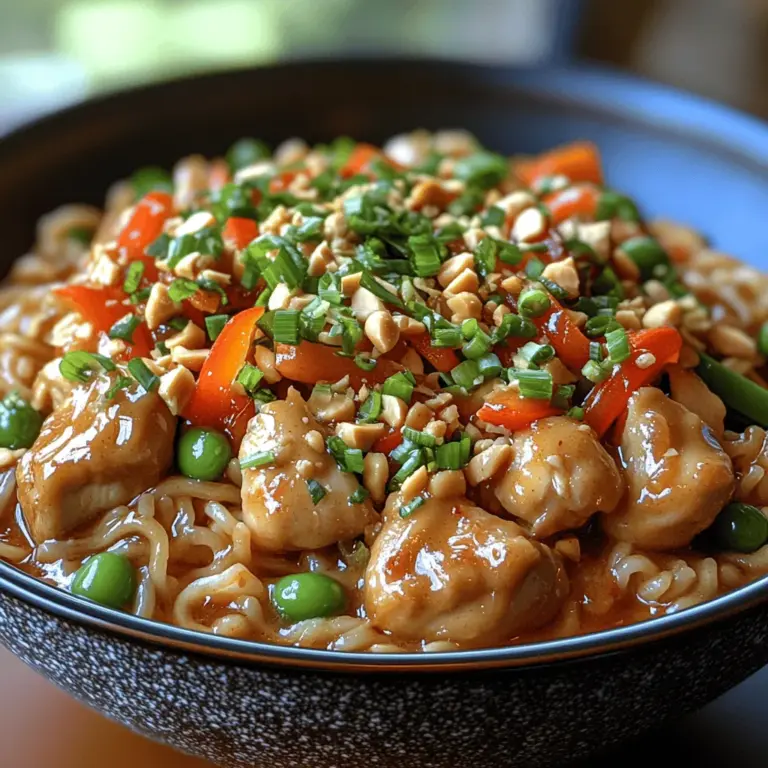Introduction
Spicy Thai Peanut Chicken Noodles, a dish that embodies the essence of Thai cuisine, is not just a meal; it’s a culinary experience that transports your taste buds to Southeast Asia. This dish combines tender chicken, vibrant vegetables, and a rich, creamy peanut sauce, all tossed with rice noodles to create a harmonious balance of flavors and textures. The cultural significance of this dish is rooted in Thailand’s diverse culinary heritage, where the infusion of bold spices and fresh ingredients is celebrated.
As lifestyles become increasingly busy, meals like Spicy Thai Peanut Chicken Noodles offer a quick yet satisfying option for those seeking to enjoy a flavorful dish without spending hours in the kitchen. With its blend of sweet, salty, and spicy notes, this recipe is not only a delight to the palate but also a fantastic way to bring the essence of Thai street food to your home.
The Allure of Thai Cuisine
Thai cuisine is renowned worldwide for its complexity and depth of flavor. It is a culinary tradition that emphasizes the balance of four fundamental tastes: sweet, salty, sour, and spicy, which come together to create a symphony of flavors in each dish. This balance is achieved through the use of fresh herbs, spices, and the careful selection of ingredients, making every meal a celebration of taste.
Key ingredients commonly found in Thai cooking include lemongrass, galangal, kaffir lime leaves, fish sauce, and, of course, chili peppers. Each of these components plays a vital role in developing the unique flavor profiles that Thai dishes are known for. The use of fresh produce and aromatic herbs not only enhances the taste but also contributes to the nutritional value of the cuisine.
In addition to the flavors, the textures in Thai dishes create a delightful eating experience. From the crunch of fresh vegetables to the chewiness of noodles, every bite is meant to provide a new sensation. It’s this combination of taste and texture that makes Spicy Thai Peanut Chicken Noodles an irresistible choice for any meal.
Understanding the Ingredients
To create the perfect Spicy Thai Peanut Chicken Noodles, it’s essential to understand the role of each ingredient in the dish. Here’s a breakdown of the key components that come together to make this recipe a standout.
Rice Noodles
Rice noodles are the foundation of this dish, providing a light and chewy base that absorbs the flavors of the peanut sauce beautifully. There are various types of rice noodles, including thin vermicelli, flat wide noodles, and thicker varieties. For this recipe, flat rice noodles, often referred to as “pad thai noodles,” are preferred due to their ability to hold up against the rich sauce while still providing a satisfying bite.
Cooking rice noodles is generally straightforward. They can be soaked in hot water until soft or boiled briefly, depending on the thickness. It’s important to avoid overcooking them, as they can become mushy and lose their desirable texture.
Chicken Thighs
While chicken breast is a popular choice for many recipes, chicken thighs are preferred for this dish due to their juiciness and richer flavor. Thighs have a higher fat content, which keeps the meat moist during cooking and enhances the overall taste of the dish. When sliced thinly and cooked quickly, they become tender and flavorful, making them a perfect complement to the peanut sauce.
Vegetables
Fresh vegetables are integral to Spicy Thai Peanut Chicken Noodles, not only for their nutritional benefits but also for the colors and textures they bring to the dish. Common vegetable additions include bell peppers, carrots, and snap peas. These vegetables are rich in vitamins and minerals, contributing to a well-rounded meal. They also provide a satisfying crunch that contrasts beautifully with the creamy peanut sauce.
Peanut Sauce
The star of Spicy Thai Peanut Chicken Noodles is undoubtedly the peanut sauce. This creamy, savory sauce is made from a blend of peanut butter, soy sauce, lime juice, brown sugar, and chili paste. Each ingredient plays a crucial role: the peanut butter offers a rich, nutty flavor; the soy sauce adds umami; lime juice introduces acidity; and brown sugar brings sweetness, counterbalancing the heat from the chili paste.
Achieving the perfect consistency for the peanut sauce is essential. It should be thick enough to cling to the noodles and chicken but smooth enough to blend seamlessly with the other ingredients.
Ingredient Substitutions
For those with dietary restrictions, this recipe can be easily adapted. To make it gluten-free, simply use tamari instead of soy sauce and ensure that your rice noodles are certified gluten-free. For a vegan version, swap the chicken for tofu or tempeh and ensure that all other ingredients are plant-based. The sauce can also be made with almond or sunflower butter if peanut allergies are a concern.
Preparing Your Spicy Thai Peanut Chicken Noodles
Now that we’ve explored the ingredients, it’s time to dive into the preparation of this delicious dish. Below is a step-by-step guide to cooking the rice noodles, making the peanut sauce, and assembling the dish to achieve the perfect balance of flavors and textures.
Cooking the Rice Noodles
1. Soak or Boil: Depending on the type of rice noodles you are using, either soak them in hot water for about 15-20 minutes until softened or boil them in salted water for 3-5 minutes. Keep an eye on them to avoid overcooking.
2. Drain and Rinse: Once cooked, drain the noodles and rinse them under cold water to stop the cooking process. This step also prevents them from sticking together.
3. Set Aside: Toss the noodles with a little oil to keep them separated while you prepare the other components of the dish.
Making the Spicy Peanut Sauce
1. Combine Ingredients: In a mixing bowl, combine 1/2 cup of creamy peanut butter, 1/4 cup of soy sauce (or tamari for gluten-free), the juice of one lime, 2 tablespoons of brown sugar, and 1-2 tablespoons of chili paste, depending on your heat preference.
2. Mix Until Smooth: Whisk the ingredients together until you achieve a smooth consistency. If the sauce is too thick, you can add a few tablespoons of warm water until it reaches your desired thickness.
3. Taste and Adjust: Taste the sauce and adjust the flavors as needed. You might want to add more lime juice for acidity or more sugar for sweetness, depending on your palate.
Cooking the Chicken and Vegetables
1. Prepare the Chicken: Thinly slice the chicken thighs into bite-sized pieces. This will allow them to cook quickly and evenly.
2. Stir-Fry: In a large skillet or wok, heat a tablespoon of oil over medium-high heat. Add the chicken and stir-fry for about 5-7 minutes, or until cooked through and no longer pink. Remove the chicken from the skillet and set aside.
3. Cook the Vegetables: In the same skillet, add another tablespoon of oil if necessary. Add your chosen vegetables and stir-fry for about 3-4 minutes until they are tender-crisp.
4. Combine Everything: Add the cooked chicken back into the skillet with the vegetables, along with the drained rice noodles and the peanut sauce. Toss everything together to combine, ensuring that the noodles and chicken are evenly coated with the sauce.
With these initial steps, your Spicy Thai Peanut Chicken Noodles are well on their way to being a reality. The next part of the article will delve deeper into tips for achieving the best results and common questions related to this delightful dish. Stay tuned for more insights and culinary advice!

Cooking the Chicken: Techniques for Achieving Tenderness and Flavor
To create a delicious base for your Spicy Thai Peanut Chicken Noodles, it’s essential to cook the chicken perfectly. Start with boneless, skinless chicken breasts or thighs, as both options will yield tender, juicy results. Marinating the chicken in a mixture of soy sauce, lime juice, and a dash of sesame oil for at least 15-30 minutes before cooking will infuse it with flavor and help to tenderize the meat.
When it’s time to cook, heat a tablespoon of vegetable oil in a large skillet or wok over medium-high heat. Ensure that the oil is hot before adding the chicken; this will help to sear the meat and lock in juices. Cook the chicken in a single layer, avoiding overcrowding the pan, which can cause steaming rather than browning. Allow the chicken to cook undisturbed for about 3-4 minutes before flipping it to the other side. This technique not only enhances the flavor through caramelization but also helps achieve a pleasing texture.
Once the chicken is fully cooked—registering an internal temperature of 165°F (75°C)—remove it from the skillet and let it rest for a few minutes. This resting period allows the juices to redistribute throughout the meat, ensuring each bite is moist and bursting with flavor.
Stir-Frying Vegetables: Maintaining Crunch and Vibrant Color
The vegetables in this dish are not just a garnish; they play a crucial role in delivering texture and nutrients to your meal. To achieve that perfect balance of crunch and vibrancy, select a variety of colorful vegetables like bell peppers, carrots, and snap peas. These not only bring aesthetic appeal but also contribute a range of vitamins and minerals.
Before stir-frying, ensure all vegetables are prepped and sliced uniformly to ensure even cooking. Heat the same skillet you used for the chicken, adding a splash of oil if necessary. Add the vegetables that take longer to cook first, such as carrots, followed by quicker-cooking options like bell peppers and snap peas. Stir-frying over high heat for a short duration—about 2-3 minutes—is key to maintaining their crispness. This technique allows the vegetables to retain their vibrant colors while developing a slight char, enhancing their natural sweetness.
Combining the Flavors
Once the chicken and vegetables are cooked to perfection, it’s time to bring everything together. Return the cooked chicken to the skillet with the vegetables, and pour in the pre-prepared spicy Thai peanut sauce. The timing here is crucial; make sure everything is added to the pan while it’s still hot to ensure the sauce warms up and coats all the ingredients evenly.
Gently toss everything together, allowing the sauce to meld with the chicken and vegetables. The heat from the skillet will help the sauce cling to each piece, ensuring every bite is packed with flavor. If desired, sprinkle some chopped green onions or fresh cilantro over the top for added freshness.
For serving and plating, consider using a large bowl or plate to showcase the vibrant colors of the dish. A sprinkle of crushed peanuts and a wedge of lime on the side can add visual interest and an additional flavor dimension, inviting your guests to squeeze a bit of fresh lime juice over their noodles before enjoying.
Nutritional Information
This Spicy Thai Peanut Chicken Noodles dish is not only flavorful but also nutritious. Each serving is packed with protein from the chicken, healthy fats from the peanut butter, and a variety of vitamins and minerals from the colorful vegetables. Here’s a general overview of the nutritional profile per serving:
– Calories: Approximately 450-500
– Protein: 30-35 grams
– Carbohydrates: 40-50 grams
– Fat: 20-25 grams (depending on the amount of peanut butter used)
– Fiber: 4-5 grams
The ingredients used offer various health benefits. For instance, peanuts are a great source of healthy fats and protein, while vegetables like bell peppers and carrots provide antioxidants and vitamins A and C. This dish can be a balanced meal option, especially when served with a side of steamed vegetables or a light salad to increase fiber intake.
Tips for Customization
One of the great things about this recipe is its versatility. Feel free to customize the dish based on your preferences or dietary restrictions. If you want to switch up the protein, shrimp or firm tofu are excellent alternatives. Shrimp can be cooked similarly to chicken, while tofu should be pressed to remove excess moisture and then diced before cooking.
Additionally, you can experiment with the vegetable mix. Broccoli, zucchini, and baby corn are great choices that can add different textures and flavors to the dish. If you like it spicier, consider adding red pepper flakes or a dash of sriracha to the sauce.
For those who prefer milder flavors, reducing the amount of chili paste or adjusting the sauce can help tone down the heat. You can also serve the dish with a side of coconut rice or a refreshing cucumber salad to complement the spiciness of the noodles.
Storing and Reheating Leftovers
If you have leftovers, proper storage is key to maintaining the dish’s quality. Allow the Spicy Thai Peanut Chicken Noodles to cool completely before transferring them to an airtight container. They can be stored in the refrigerator for up to 3 days.
To reheat, simply transfer the noodles to a skillet over medium heat, adding a splash of water or a little extra peanut sauce to prevent sticking and to reintroduce moisture. Stir gently until heated through, being careful not to overcook the noodles, which can make them gummy.
For microwave reheating, place the noodles in a microwave-safe dish, cover with a damp paper towel, and heat in short intervals of 30 seconds, stirring in between, until warmed through.
Conclusion
Spicy Thai Peanut Chicken Noodles are not only a delightful combination of flavors and textures but also a simple recipe that can be easily adapted to suit personal tastes. The ease of preparation makes it a perfect choice for busy weeknights or when you want to impress guests with a gourmet meal without spending hours in the kitchen.
Encouraging experimentation with different ingredients and flavors can lead to even more creative variations of this dish. Cooking is not just about following recipes; it’s about expressing your culinary creativity and sharing delicious meals with loved ones. So gather your ingredients, embrace the joy of cooking, and enjoy the satisfaction of a home-cooked meal that brings warmth and happiness to your dining table.

